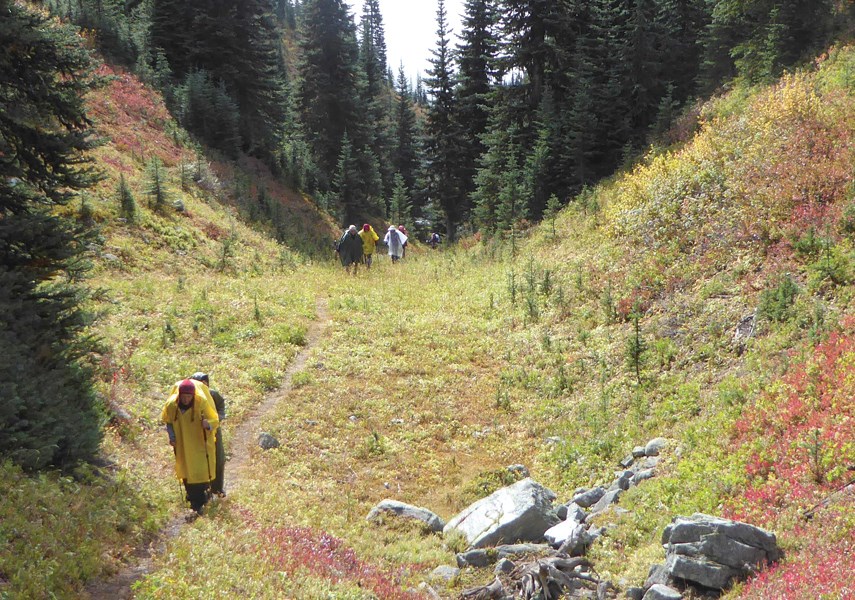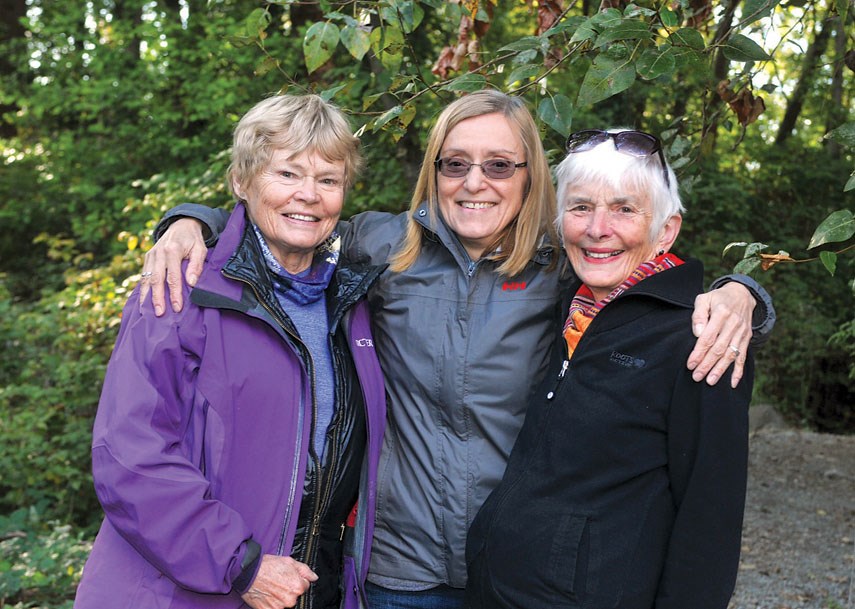“Sad too, that he lies buried on a trail he disliked.”
Sign on the Hudson’s Bay Company trail
As the engines zipping along the Coquihalla Highway faded in the wind, 14 hikers and one dog strode away from civilization and into history.
For hikers Anne Leathem, Lyn Grants and Shari Laszlo, the trip along the Hudson’s Bay Company trail was about companionship, nature, and getting a glimpse of British Columbia when fur was currency and gold was still in the hills.
“It was hard not to be awestruck,” Grants says.
She could see where hundreds of cattle and pack horses navigated the winding, 74-kilometre journey between B.C.’s Coast and Interior.
The HBC trail at first resembles the reading from a Richter scale following a minor seismic event, as the eastern path dips south, north, south and north again before a smooth arc emerges that leads travellers to Tulameen.
With Hope at their backs, the Golden Age Hiking Club navigated lakes, creeks, and mountains over seven days.
Asked about the hiking group’s name, Grants laughs.
“We don’t like the name but . . . we’re stuck with it.”
The experience was a chance to give written the dimensions, smells and sounds of real experience, Laszlo explains.
At one juncture near Deer Camp she realized an HBC trader likely stood in that same spot 162 years ago – possibly with blood and sap on his hands.
It was the spot where Paul Fraser met his peculiar fate.
Reviled by the men he led, Fraser was reputed to have once beaten an employee to death, according to the Hope Mountain Centre.
Fraser died in his sleep near Deer Camp. However, the cause of his death may not have been entirely natural.
His workers were cutting trees for firewood while Fraser was sleeping. One tree fell and walloped Fraser’s tent, killing him.
“Fraser was widely despised, and historians have speculated that it was no accident,” reads an account provided by the Hope Mountain Centre.
Looking at the soil, several members of the hiking group said they may have spotted Fraser’s grave based on the soil and a description left by one of the firewood cutters.
The workers were French Canadians, First Nations and Hawaiians. Paid in “drams” of rum and “regales” of tobacco, the life expectancy of HBC employees was 45, according to the Hope Mountain Centre.
As some members of the more recent HBC fellowship were in their 70s, the hikers were helped out by vehicle assist. A truck would rendezvous with the hikers, load up their packs, and meet them at the next stop.
Without that assist from Mt. Waddington’s Outdoors, “We’d be lucky if we could get over one mountain range,” Leathem says.

The group hiked through snow and smoke as the remnants of B.C.’s wildfires obscured mountain peaks. The hardest days were the ones when they got closer to those peaks, Leathem notes.
“If we survived the first day we might be able to make it,” she recalls thinking.
For Grants, the lasting memory of the trail is the colour, which included “the gold of the highbush rhododendron” and “every shade of purple to mauve to pink you could imagine.”
A botany-minded member of the hiking party also noted a swath of grass along the trails that looked out of place, having likely been planted by an HBC trader to provide the horses with a snack along the trail.
The trail was originally a trading route for Sto:lo, Nlaka’pamux and Similkameen First Nations bearing tobacco, sage, hemp, and dried salmon, according to the Hope Mountain Centre.
Hudson’s Bay Company employees were wandering the countryside in search of a trading route to replace the Columbia River routes snatched from the British following the establishment of the 49th parallel. However Similkameen Chief Blackeye showed the hunting and trading route to Alexander Caulfield Anderson in 1846, allowing for the establishment of the HBC trail.
“For more than a decade, the HBC’s fur empire in Western North America depended on this trail,” according to the Hope Mountain Centre.
It was a well-travelled road until about 1860, when the fur trade declined in the wake of gold fever and a few more efficient routes to the Interior were established.
The trail has been largely re-opened since 2009, allowing hikers to tread the historic route.
“It makes you feel wonderful to be out there,” Leathem says
“It’s almost impossible to describe,” Laszlo agrees. “Going to bed with the sun, waking up with the sun, leaving everything behind.”
Those trips have a way of making everything else disappear, Laszlo explains.
“Here, when I go to sleep at night I’m kind of agitated. I’ve got this chore to do for home, I’ve got that to do for work, I’ve got to call so-and-so, I’ve got to email so-and-so,” she says. “There, it doesn’t even exist.”



